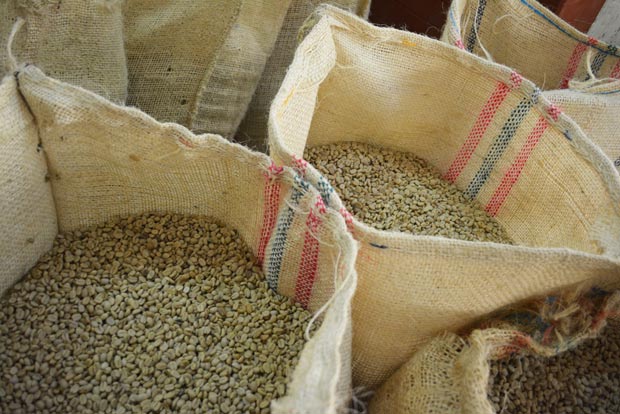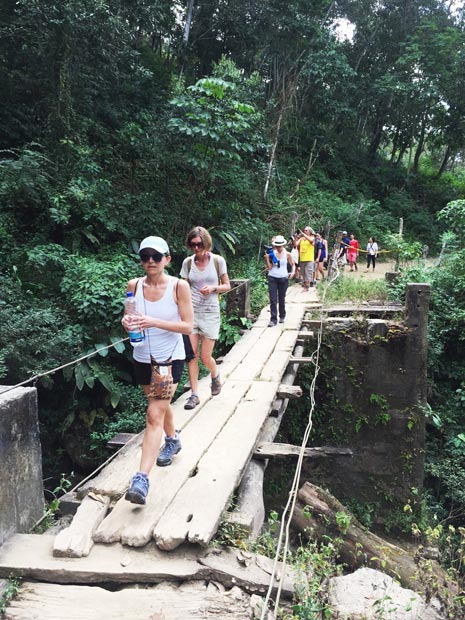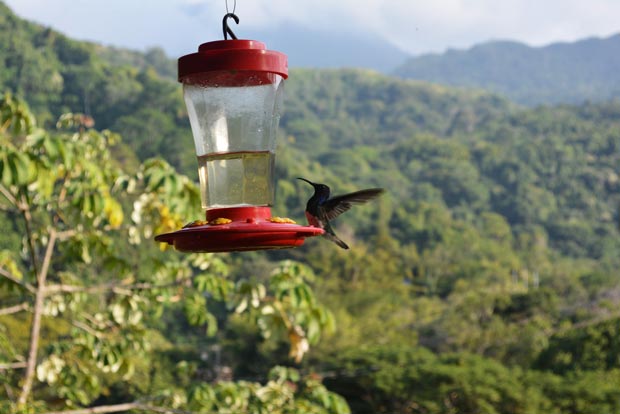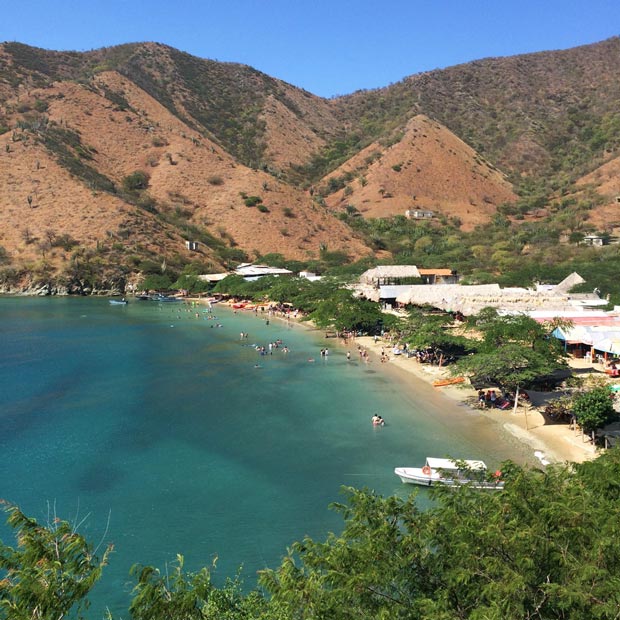Discover the mountains and waterfalls of Colombia’s Santa Marta region
If you’re seeking wild beaches, hiking trails and relaxing swimming spots, then Colombia’s Santa Marta region might be your next holiday destination.
Santa Marta is located on Colombia’s Caribbean coast and acts as a base or jumping point to the beautiful Tayrona National Park and the Sierra Nevada mountains. Santa Marta is about a three-hour drive from the colonial city of Cartagena – one of South America’s oldest cities. Flights are available from a number of US cities into Colombia via Cartagena or Santa Marta.
During your visit to Santa Marta, places of interest include the Tayrona Gold Museum and the Quinta San Pedro Alejandrino, the house where renowned political leader Simón Bolívar spent his final days. Simón Bolívar was instrumental in freeing some South American countries including Colombia from Spanish rule. Quinta de San Pedro Alejandrino features pretty gardens and a museum.
The Tayrona Gold Museum is located on Calle 14 near Bolivar Park and features a number of pottery and gold artefacts, including gold jewellery. There are also a number of beaches near the heart of Santa Marta, several marketplaces to pick up souvenirs, and you can watch the sunset from the seawall near the port. Lovers’ Park in Santa Marta’s centre is a hive of activity at night with a number of bars and restaurants nearby. Make sure you head to the Hemingway Bar for a drink before or after dinner. Good spots to eat are located on Carerra 3 between Carre 16 and 17 (the town centre is set in a grid pattern and is easy to follow). One restaurant worth trying is the LaMart restaurant. Colombian cuisine is made up of a lot of seafood, as well as rice, plantain and banana.
Sierra Nevada mountains
Most travellers come to Santa Marta to explore the nearby national parks. The closest park is Sierra Nevada. The Sierra Nevada mountains are the world’s highest coastal mountain range - the highest point located only 42 kilometres from the Caribbean coast. This area is a great spot for hiking, as well as growing coffee and cocoa due to the high altitudes and you’ll see a lot of local products come from this area. The mountain range is rich in biodiversity, and animals include cougars, jaguars and deer, as well as more than 400 species of birds. Among the bird species in the park are hummingbirds, condors and vultures.
From Santa Marta, I headed out to the Sierra Nevada mountains to visit the La Victoria coffee plantation, hike to a swimming hole and see hummingbirds. Minca is the gateway town for the Sierra Nevada mountains – located about 45 minutes from Santa Marta depending on traffic - but there’s not a lot there except for several accommodation options so you’ll only use Minca as a base.
The La Victoria coffee plantation is located at the end of a very bumpy dirt track – a 4WD is recommended to traverse the path and tours are available. La Victoria is the oldest coffee plantation in Colombia still in operation, dating back to 1892. Self-proclaimed Jungle Joe Ortiz led my tour group through the facility, taking us through the coffee making process from the harvesting of the coffee beans, fermentation, drying and roasting.

During the tour, we got up close to the equipment used in the process. The equipment is over 150 years old, dating back to the Industrial Revolution, but it’s surprisingly still in good working order.
Next up, we went on a hike to a swimming hole not far from the coffee plantation – led there by Jungle Joe’s daughter. There’s a number of swimming holes in the Minca area including the Marinka waterfall and the Pozo Azul waterhole. The swimming spot we visited was located about a 45-minute walk from the village of Minca along a wide dirt trail. The walk is relatively easy and every now and then, you’ll come to a beautiful viewpoint over the Sierra Nevada mountains.

The swimming hole is cold but refreshing, but with a strong current. It’s a beautiful spot to take in the view and go for a quick dip. But bring some insect repellent with you as there are a few bugs around.

Want to see hummingbirds? Then head out to Hotel Minca. You can see about half a dozen hummingbirds at any one time flit around the hotel’s balcony. If travelling independently, there’s a small fee for entry to look at the hummingbirds.

Jungle Joe offers a range of tours in the Sierra Nevada area. For more information, visit www.junglejoeminca.com
After my group’s day trip to Minca, we headed to the small town of Taganga. Taganga is a gritty town with dirt roads and packs of stray dogs, but it does have a nice beach if you want to use it as a base to reach the surrounding natural areas. Expect you and your belongings to be covered in a layer of dust by the end of each day though.
If you’re looking for an accommodation option, Ocean Taganga is a clean and central hotel with lots of hammocks to laze around on and read a good book. However, like many hotels along Colombia’s Caribbean coast, rooms only have cold water showers. In Taganga, head to the Grande (Big) Beach. It’s accessible from the Taganga centre by a dirt trail. The walk takes about 15 minutes and offers great views of the surrounding area. The trail is very exposed though, so bring a hat, water and slap on some sunscreen before you head out.

Some activities are on offer at the beach including snorkelling, kayaking, and banana boat rides. The beach also has a row of bars and restaurants so you can easily spend a whole day there.
Back in Taganga, if you’re looking for a bite to eat at dinner time, try the Pachamama restaurant. The restaurant offers an extensive range of cocktails and big meal servings. Seafood lovers will find a lot of choices on the menu.
Things you should know:
- Santa Marta and Taganga are considered to be unsafe to walk alone at night. Always walk in at least pairs at night. It’s recommended to bring some Colombian pesos with you to Taganga as there is only one ATM in town which is said to be often not operational.
- Bring lots of insect repellent – there are lots of mosquitoes and midges around.
- US Dollars is not accepted along with the Caribbean coast so you’ll need to exchange US Dollars for Colombian Pesos. A reasonable rate is 3000 pesos per one US Dollar. If possible, try to give exact amount especially at restaurants – it can be challenging to get change back.
- It’s recommended not to drink the water in Colombia.
- When in Colombia, you’re on Colombia time. Use transit times as a guide and expect to wait up to an hour for food as restaurants have small kitchens.
- Along Colombia’s Caribbean coast, not all hotels have hot water. If it’s a must for a hot shower, read hotel reviews before booking to find out if they have hot water or not.
Lisa Owen is a pint-sized Australian following her dreams to travel to as many places as she can, and loves to share her photography, travel hacks, hiking adventures, and food discoveries along the way. At last count, she has travelled to more than 40 countries in between working in public relations and discovering hidden gems in Australia's great outdoors. Instagram: @_thelittleadventurer Facebook: The Little Adventurer Australia
The views, opinions and positions expressed by the author and those providing comments are theirs alone and are meant as travel inspiration only. They do not reflect the opinions of Cover-More Insurance. You should always read the PDS available from your travel insurance provider to understand the limits, exclusions and conditions of your policy and to ensure any activities you undertake are covered by your policy.